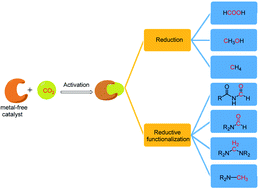From CO2 activation to catalytic reduction: a metal-free approach
Abstract
Over exploitation of natural resources and human activities are relentlessly fueling the emission of CO2 in the atmosphere. Accordingly, continuous efforts are required to find solutions to address the issue of excessive CO2 emission and its potential effects on climate change. It is imperative that the world looks towards a portfolio of carbon mitigation solutions, rather than a single strategy. In this regard, the use of CO2 as a C1 source is an attractive strategy as CO2 has the potential to be a great asset for the industrial sector and consumers across the globe. In particular, the reduction of CO2 offers an alternative to fossil fuels for various organic industrial feedstocks and fuels. Consequently, efficient and scalable approaches for the reduction of CO2 to products such as methane and methanol can generate value from its emissions. Accordingly, in recent years, metal-free catalysis has emerged as a sustainable approach because of the mild reaction conditions by which CO2 can be reduced to various value-added products. The metal-free catalytic reduction of CO2 offers the development of chemical processes with low cost, earth-abundant, non-toxic reagents, and low carbon-footprint. Thus, this perspective aims to present the developments in both the reduction and reductive functionalization chemistry of CO2 during the last decade using various metal-free catalysts.

- This article is part of the themed collections: Celebrating the Chemical Sciences in India - Leaders in the Field Symposium 2021, Celebrating the Chemical Sciences in India - Leaders in the Field Symposium 2020, Celebrating 10 years of Chemical Science and Celebrating the Chemical Science in India - Leaders in the Field Symposium


 Please wait while we load your content...
Please wait while we load your content...